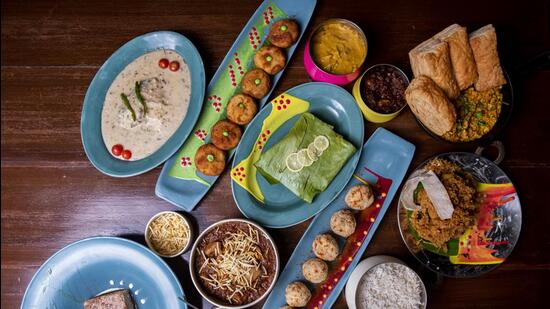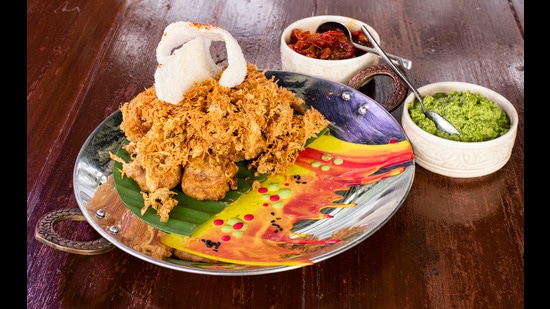Navroz Feast: Jamva Chalo ji
As Nowruz has just gone by, we look at some mouth-watering Parsi foods that is heavy on meat yet simple in preparation and ingredients
The parsi community arrived in india between the 8th to the 10th century docked at our shores from Iran where they were being persecuted. They set up their lives along the coast of Maharashtra and Gujarat, predominately. Their culture, food, language and clothes have undergo many changes ans have becomes heavily influenced by the people they met as they assimilated in India.


Flavourful, meat heavy, Parsi cuisine packs a lot of bang with simple ingredients and spices. As the Parsi community celebrates their new year today, we take a look at some of their traditional food dishes and what goes into preparing their delectable meals.

Kolmi na kebab
Kolmi is prawns and is very similar to the Marathi word for prawn – kolbi. Parsi’s also use the word Kebab for any kind of fried snacks that they serve. The kebabs are made by marinating the prawns in a mix of fresh and dry spices such as dhaniya, jeera, fresh coriander, parsi vinegar. This mix is made into balls and coated in rava and fried till crispy and golden. You end up with a juicy centre and a crispy exterior.

Chicken Farcha
every culture and cuisine has a fried chicken and farcha is quientesential parsi fried chicken. The chicken is cooked with a simple onion tomato masala and dry spices like coriander, red chilli powder, jeera and the cooked chicken is marinated in this masala for a few hours. The parsi wil always use big cuts of chicken that is on the bone. The cooked chicken is then coated with bread crumbs or rava and dipped in egg + water batter and fried on a very high heat to form a type of egg floss, giving it the signature chicken farcha look.

Egg and chutney pattices
The parsi love their green chutney and use it in many ways. Another way they incorporate this chutney in their food is by making an egg and chutney pattice. Boiled eggs are peeled and quatered and covered in chutney. It is then coated with mashed potatoes and rolled in rava and fried till golden brown.

Akuri toast
Parsis looks their eggs that they will even add eggs to their bhaajis Tomato Per Eedu or Bheeda per Eendu. Akuri is a simple egg scrambled dish and every parsi household has their own version. Some are made with extra garlic or with an addition of dry fruits. The akuri’s masala is made up of onions, tomatoes, green chillis and your usual spices like haldi, red chilli, coriander and cumin. This masala is cooked really well which is unlike a bhurji that is a quick and fast egg scramble. The ways the eggs are cooked also differes from the typical indian breakfast dish since in the akuri, the eggs are poured into the masala and folded as they cook. The eggs are also not cooked till they are completely set instead it is left the slightest bit under done and runny. It is usually eaten with toast and can be eaten with khari as well.

Sauce nimachhi
colloquially sass ni machi, this dish is made with pomfret fish in a sweet-sour, white sauce. The sauce or gravy is made with fish stock and thickened with eggs and rice flour (not maida). It is flavoured with the famous Navsari vinegar and a little sugar for sweetness. Spice like cumin, green chili, tomatoes, fresh coriander and garlic is added. The whole fish is added to the sauce and is essentially left to simmer and poach so you get a soft, lightly cooked fish. When it is made at home, parsi will eat it with a yellow dry kichri. Kichri sauce is a common dish that that is eaten in a parsi household. However, at celebrations, it is just this dish that will make up the first course.

Patrani machi
This iconic parsi dish is essentially a whole fish coated in a green chutney and steamed in a banana leaf. The idea of steaming a fish in a banana leaf is two fold – to impart its own flavour and to hold the thick marinade. Also since the parsi’s believe in not creating too much waste or pollute the earth, using the banana leaf makes it a eco-friendly cooking. The chutney is making of corriender, jeera, ginger, coconut, chillies, sugar or jaggery and the parsi vinegar. The fish is marinated with dry spices and then coated with this green chutney and wrapped in the leaf. To steam the fish, the water is spiked with the parsi vinegar as well so that the flavour of the chutney is not diluted. The fish is steamed low and slow so that you don’t end up with watery fish or overcooked mush.

Dhan dal patio
this dish is eaten on any good occasion, including new year. It is a simple dish comprising of white rice, lightly tempered yellow dal, and a type of prawn pickle. The mori dal is made with tur dal and a tadka of garlic and jeera in pure ghee. This comforting dish is jazzed up with a sweet spicy and tangy pickle that is made using onion, tomatoes and eggplant and either prawn or fish is added to it.

Salli Boti
This dish is made with small chunks of boneless mutton cooked in a masala that is made up of onion, tomatoes and minimal spices. It is also one of the only parsi dishes that uses garam masala and is is cooked low and slow. It is sweetened with jaggery and dried apricot called zardalu. This is the most common and popular type of Sali boti that every parsi household will make. It is topped with sallies that is fried crispy potato to give it some crunch.

Lagan nu custard
One of the most popular dishes is this custard that is mainly made for lagans or weddings. It is said that anyone who eats this custard will get married within the year. It is made with full fat milk and sugar for a certain period of time till the sugar dissolved and the milk caramelises and then mixed with eggs. It is flavoured with nutmeg, rosewater and a touch of cardamom and topped with charoli nuts. It is traditionally cooked in a wood fire oven till but it can be cooked in a convection oven as well.

Dudh nu puff
This cool drink is a take on vanilla milkshake. However, instead of slurping thick shake you are spoon cooled milk foam that is flavoured with vanilla. Sweetened milk is beaten and the froth is set in a cup in the fridge. It is eaten as a dessert or for breakfast and a childhood favourite for parsi kids.
Dhansak
A Sunday staple and one of the most popular parsi dishes, mutton dhansak is never eaten on a happy occasion. This is typically the first dish eaten by the parsi after they complete the obligatory four days period when the parsis turn vegetarian after a death in the family. However, this dish is eaten on the regular when the whole family gets together on the weekends.
Rotla
very thin roti with a certain amount of fat in the dough via ghee or oil that keeps the roti soft for a long period of time. They do not have too much dry flour in it.
Parsi brown rice
sweet caramalised rice, this brown rice usually accompanied the mutton dhansak. It is an easy dish and it gets its brown hue from the caramelisation of the sugar and onions.
Inputs by: Chef Yajush Malik, Head Chef, Gallops, Mumbai
Location: Gallops, Mumbai
Catch your daily dose of Fashion, Health, Festivals, Travel, Relationship, Recipe and all the other Latest Lifestyle News on Hindustan Times Website and APPs.



